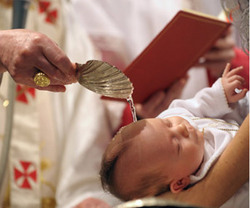 Today is the feast of the first companions of Saint Benedict of Norcia, Saints Maurus and Placid. The traditional blessing of the sick calling upon Saint Maurus’ intercession follows. You may not have a relic of the True Cross or relic of Saint Benedict to you available to you, so the priest should use a crucifix and the Saint Benedict Medal.
Today is the feast of the first companions of Saint Benedict of Norcia, Saints Maurus and Placid. The traditional blessing of the sick calling upon Saint Maurus’ intercession follows. You may not have a relic of the True Cross or relic of Saint Benedict to you available to you, so the priest should use a crucifix and the Saint Benedict Medal.
Before the blessing is imparted, the relic of the true Cross of our Lord or the medal of Saint Benedict is exposed, at least two candles having been lit. The Act of Contrition and firm confidence should then be excited in the sick person, so that through the merits and intercession of Saint Benedict and Saint Maurus, if it should please God, health may be obtained. Three Our Fathers, Hail Marys and Glory be’s are recited in honor of the Blessed Trinity.
Then a priest or deacon, having put on a stole, and with his right hand holding up the relic or the medal of Saint Benedict before the sick person, says the following prayers:
V. Benediction and glory, and wisdom, and thanksgiving, honor and power and strength to our God forever and ever.
R. Amen.
V. My foot has stood in the direct way.
R. In the churches I will bless You, O Lord.
Invocation
Through the invocation of the most holy name of the Lord may that faith, in which St. Maurus, by employing the words of this blessing, healed the sick, and in which I, though an unworthy sinner, utter the selfsame words, restore your health as you desire:
In the name of the most holy and undivided Trinity and supported by the merits of the most holy Father Benedict, I bid you, N., to rise, stand upon your feet and be cured, in the name of the Father and of the Son + and of the Holy Spirit.
R. Amen.
Antiphon
Surely He has borne our infirmities and carried our sorrows: by His bruises we are healed.
V. He that forgives the iniquities of his creatures.
R. May He heal your infirmities.
V. O Lord, hear my prayer.
R. And let my cry come to You.
V. The Lord be with you.
R. And with your spirit.
Let us pray
O God, the Creator, of all things, You ordained that Your only Son should take flesh of the Virgin Mary by the power of the Holy Spirit for the restoration of your people and You deigned to heal the wounds and infirmities of our souls by the redemption accomplished upon the sacred and glorious wood of the life-giving Cross: do You also vouchsafe through this powerful sign to restore health to Your servant N.
Through the same Christ our Lord.
R. Amen.
Let us pray
Lord Jesus Christ, You conferred upon the master, blessed Benedict, the privilege of obtaining from You whatsoever he might ask in Your name: vouchsafe, through his intercession, to heal all the infirmities of this Your servant: in order that, being restored to health, he (she) may give thanks to Your holy name.
You live and reign with the Father and the Holy Spirit for ever and ever.
R. Amen.
The Blessing
Through the invocation of the Immaculate Mother of God and ever Virgin Mary, and the intercession of Saints Benedict and Maurus, may the Power + of God the Father, the Wisdom + of God the Son, and the Strength + of the Holy Spirit free you from your infirmities. Amen.
May God’s holy will be done, and may it be done to you as you wish and pray, for the praise and honor of the most holy Cross of our Lord Jesus Christ.
The priest then blesses the sick person with the relic of the Cross or the medal of St. Benedict saying:
May the blessing of Almighty God, of the Father and of the Son + and of the Holy Spirit descend upon you and abide with you forever.
R. Amen.
The sick person then kisses the relic or the medal of St. Benedict.
This blessing, if need be, may be repeated three times; also three votive Masses may be celebrated, namely in honor of the Passion, of St. Maurus, Abbot, and for the Poor Souls; otherwise the fifteen decades of the Rosary of the Blessed Virgin Mary are to be prayed according to the aforesaid intentions by the sick person, or by others in the person’s name.








